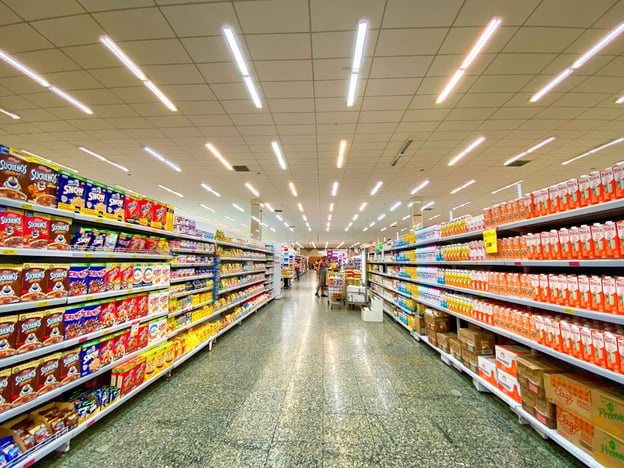 Getting lost in a store is literally the stuff of nightmares for many. Granted, not knowing how to find the products you want or the people you came in with is not quite as high stakes of a nightmare situation as falling out of an airplane or trying to survive a zombie apocalypse, but it’s far from the kind of shopping experience customers desire — or the kind of shopping experience that store planners and location managers want to provide. Good retail store design and a sensible store layout are both helpful ways to address this issue, but a retail map is what you need to directly tackle the problem.
Getting lost in a store is literally the stuff of nightmares for many. Granted, not knowing how to find the products you want or the people you came in with is not quite as high stakes of a nightmare situation as falling out of an airplane or trying to survive a zombie apocalypse, but it’s far from the kind of shopping experience customers desire — or the kind of shopping experience that store planners and location managers want to provide. Good retail store design and a sensible store layout are both helpful ways to address this issue, but a retail map is what you need to directly tackle the problem.
That’s easy enough to say, but how do you craft the ideal retail map and then provide it to customers in a way that they’ll actually use? You have a few options to consider (and we don’t just mean where to put your store directory), but first, let’s be clear about what we are and aren’t discussing in this map retail context.
Jump to a section…
What is a retail map?
What are some examples of a retail map?
Home Depot
Target
How are retail maps designed?
Ready to take your understanding of store planning to the next level? Check out Store Planning: The Ultimate Guide for Retail.
What is a retail map?
A retail map is a diagram used to mark the individual sections of a store, typically including at least major departments and shelves and sometimes featuring such granular information as individual item locations. While in previous decades retail maps were typically found either printed out and affixed to walls or in brochures, modern digital infrastructure makes it easy to present both customers and employees with effective and detailed maps wherever and whenever they need them — complete with AR-powered live directions from their current in-store location to the department they’re looking for.
For even more information and ideas on how to use readily available technology to create a more effective retail sales environment, read our Guide to the New Digital Infrastructure for Malls & Retail Properties.

What are some examples of a retail map?
Now that we’ve defined what it is, let’s look at a pair of real-life examples of retail store mapping from some innovators in the brick-and-mortar space.
Home Depot
Walking into a Home Depot, with its sprawling aisles of home goods, equipment, and assorted other products, can be instantly overwhelming for anyone who isn’t a seasoned contractor or DIY aficionado. Seeking to overcome this intimidation factor to create a better shopping experience for all of its customers, Home Depot launched an updated app that comes complete with AR-powered in-store navigation tools. With approachable retail maps in hand, customers get what they need, and employees spend less time giving directions to confused visitors.
Target
The “Target Effect” is a known phenomenon, thanks in large part to the retail chain’s smartly crafted racetrack store layout. But it’s important that, on top of discovering deals on a dozen tempting items they didn’t know they needed, customers also actually find what they came in for. That’s why Target lets customers build out a shopping list in its app ahead of time, then use that list to locate the individual aisles where those items can be found via intelligent retail mapping.
How are retail maps designed?
Broadly speaking, there are two ways to do retail mapping: either in the course of creating the initial design or after the fact, when the retail space is already in operation. If your retail space is new or in the midst of an overhaul, starting with store layout maker tools can give you a creative boost with helpful design elements and templates. But even if you’re just trying to record or improve the existing mapping of a current space, creating a digital twin can pay dividends far beyond improved navigation. Building a better retail map is one of the many benefits of implementing a modern digital infrastructure in your retail space
Want to learn more about how future-proofing your retail business with proven technology can unlock new advertising revenue streams, enable precise and effective consumer data analysis, and create all-new kinds of experiences that benefit both visitors and staff? Reach out to Resonai today and set up a free demonstration.

 Getting lost in a store is literally the stuff of nightmares for many. Granted, not knowing how to find the products you want or the people you came in with is not quite as high stakes of a nightmare situation as falling out of an airplane or trying to survive a zombie apocalypse, but it’s far from the kind of shopping experience customers desire — or the kind of shopping experience that store planners and location managers want to provide. Good
Getting lost in a store is literally the stuff of nightmares for many. Granted, not knowing how to find the products you want or the people you came in with is not quite as high stakes of a nightmare situation as falling out of an airplane or trying to survive a zombie apocalypse, but it’s far from the kind of shopping experience customers desire — or the kind of shopping experience that store planners and location managers want to provide. Good 
